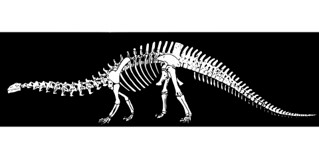Brontosaurus meaning "thunder lizard" from Greek βροντή, brontē "thunder" and σαῦρος, sauros "lizard", is a genus of gigantic quadruped sauropod dinosaurs. Although the type species, B. excelsus, had long been considered a species of the closely related Apatosaurus, researchers proposed in 2015 that Brontosaurus is a genus separate from Apatosaurus and that it contains three species: B. excelsus, B. yahnahpin, and B. parvus.
Brontosaurus had a long, thin neck and a small head adapted for a herbivorous lifestyle; a bulky, heavy torso; and a long, whip-like tail. The various species lived during the Late Jurassic epoch in the Morrison Formation of what is now North America, and were extinct by the end of the Jurassic. Adult individuals of Brontosaurus are estimated to have weighed up to 15 tonnes (15 long tons; 17 short tons) and measured up to 22 metres (72 ft) long.
As the archetypal sauropod, Brontosaurus is one of the best-known dinosaurs and has been featured in film, advertising, and postage stamps, as well as many other types of media.
Brontosaurus was a large, long-necked, quadrupedal animal with a long, whip-like tail, and fore limbs that were slightly shorter than its hind limbs. The largest species, B. excelsus, weighed up to 15 tonnes (15 long tons; 17 short tons) and measured up to 22 m (72 ft) long from head to tail.[6] For comparison, the current largest land animal, the average male African bush elephant, is 3.20 m (10.5 ft) tall at the shoulder and has a body mass of 6,000 kg (13,228 lb) or 6.6 short tons.
The skull of Brontosaurus has not been found, but was probably similar to the skull of the closely related Apatosaurus. Like those of other sauropods, the vertebrae of the neck were deeply bifurcated; that is, they carried paired spines, resulting in a wide and deep neck.[7] The spine and tail consisted of 15 cervicals, 10 dorsals, five sacrals, and about 82 caudals. The number of caudal vertebrae was noted to vary, even within a species. The cervical vertebrae were stouter than other diplodocids, though not as stout as in mature specimens of Apatosaurus. The dorsal ribs are not fused or tightly attached to their vertebrae, instead being loosely articulated. Ten dorsal ribs are on either side of the body. The large neck was filled with an extensive system of weight-saving air sacs. Brontosaurus, like its close relative Apatosaurus, had tall spines on its vertebrae, which made up more than half the height of the individual bones. The shape of the tail was unusual for diplodocids, being comparatively slender, due to the vertebral spines rapidly decreasing in height the farther they are from the hips. Brontosaurus spp. also had very long ribs compared to most other diplodocids, giving them unusually deep chests. As in other diplodocids, the last portion of the tail of Brontosaurus possessed a whip-like structure.
The limb bones were also very robust. The arm bones are stout, with the humerus resembling that of Camarasaurus, and those of B. excelsus being nearly identical to those of Apatosaurus ajax. Charles Gilmore in 1936 noted that previous reconstructions erroneously proposed that the radius and ulna could cross, when in life they would have remained parallel. Brontosaurus had a single large claw on each fore limb, and the first three toes possessed claws on each foot. Even by 1936, it was recognized that no sauropod had more than one hand claw preserved, and this one claw is now accepted as the maximum number throughout the entire group. The single front claw bone is slightly curved and squarely shortened on the front end. The hip bones included robust ilia and the fused pubes and ischia. The tibia and fibula bones of the lower leg were different from the slender bones of Diplodocus, but nearly indistinguishable from those of Camarasaurus. The fibula is longer than the tibia, although it is also slenderer.
Though it was never all plan sailing for the Brontosaurous!
The Brontosaurus really did exist, scientists have decided, ending a debate which has rumbled on for more than 100 years,
The huge dinosaur was discovered in the 1870s, but by 1903 palaeontologists ruled the fossil remains were actually from an Apatosaurus.
However, a new statistical analysis of the fossils by Oxford University has seen the dinosaur resurrected. Scientists have ruled that it is unique and should have its own genus. “The differences we found between Brontosaurus and Apatosaurus were at least as numerous as the ones between other closely related genera, and much more than what you normally find between species,” said Dr Roger Benson, a co-author from the University of Oxford. Brontosaurus is one of the most charismatic dinosaurs of all time, capturing the imagination of generations of children thanks to its mammoth size, and plodding gait, and it’s here to stay!
30 Jan 2020

